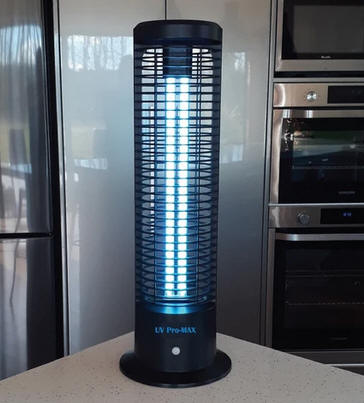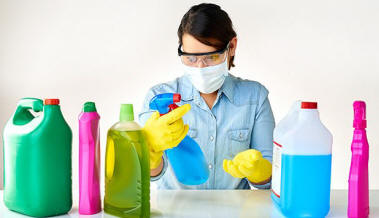WHAT ARE GERMICIDAL UV-C
ULTRAVIOLET RAYS?
Ultraviolet rays are
electromagnetic waves which form part of light.
Electromagnetic waves are divided into three
main wavelength bands, expressed in nanometers
(nm)
UV-A (315-400 nm) with tanning
properties;
UV-B (280-315 nm) with
therapeutic and vitamin “D”
UV-C (100-280 nm) with
germicidal properties.
HOW DO GERMICIDAL UV-C
RAYS WORK?
UV-C rays (100-280 nm) have a
strong germicidal effect and reach their maximum efficacy at the 265 nm wavelength.
The germicidal effect of UV-C radiation covers
bacteria, viruses, spores, fungi, molds and
mites; this is mainly due to the destructive
effect of the UV-C rays on their DNA, which
damage their reproductive system and prevent
them from replicating.
DO UV-C RAYS WORK ON
COVID-19?
The emergency of COVID 19 has
highlighted the need for an innovative approach
to disinfection needs. UV light rays have
offered positive results in the fight against
SARS and MERS, two viruses very similar to the
current COV2 Coronavirus. The use of UV-C
radiation is a safe, efficient and
cost-effective solution, avoiding the use of
hazardous chemicals.
ARE UV-C RAYS VISIBLE?
These lamps have an emission of
around 90% over the 253.7 nm wavelength. This
frequency is invisible to the human eye and has
a strong germicidal power. The remaining 10% of
the lamp’s emission is visible (typically
appearing as a blue-ish light).
ARE UV-C RAYS FOUND IN
NATURE?
Yes, UV-C rays are found in
nature as they are generated by the sun, but the
ozone layer in the atmosphere acts as a shield
which stops them from reaching the earth’s
surface.
WHAT ARE THE MAIN
ADVANTAGES OF USING GERMICIDAL UV-C LAMPS?
First, bacteria, viruses,
spores, fungi, molds and mites are all sensitive
to UV-C rays and can be eliminated by them.
Second, microbes cannot acquire resistance to
UV-C rays, which only occurs using chemical
disinfectants and antibiotics. Third, UV light
rays are eco-friendly. When using normal
disinfectants, environmental pollution is
inevitable. They also carry severe risks from
the direct inhalation of vapors or the ingestion
of foods contaminated after coming into direct
contact with chemical disinfectants. Where the
use of chemical disinfectants is unavoidable
(food/pharmaceutical/healthcare industries,
etc.), using ultraviolet rays in the
disinfection process can reduce the amount
needed, which allows for significant cost
savings and is better for the environment, while
improving disinfection quality.
WHO RECOMMENDS USING
UV-C RAYS?
Multiple organizations and
boards with a global reach, such as FDA, WHO,
EPA, CDC, ASHRAE and many others, recommend
using UV-C rays to disinfect water,
environments, and air-conditioning systems.
WHO USES UV-C RAYS?
Food and pharmaceutical
industries - for disinfecting air and
surfaces in production spaces, disinfecting
product containers (packaging), isolating
“protected” areas for product manufacturing and
packaging (such as clean rooms), and areas at
risk of contamination. These procedures
significantly increase the safety and
conservation of the products we purchase and
provide multiple health benefits since they
leave no residue and help reduce or even
eliminate the need for chemical disinfectants,
which can leave harmful residues on products.
Hospitals -
for
preventing the transmission, and therefore
contagion, of dangerous bacteria or viruses that
may be found in the air or carried following
contact with infected persons or visitors, such
as TBC and Legionella.
Air conditioning systems
- for preventing the problematic and harmful
build-up of mould and bacteria in air treatment
systems or ducts, which can cause Building
Related Illnesses (BRI), extrinsic allergic
alveolitis, viral, fungal and Rickettsial
infections, bronchial asthma, humidifier fever,
Pontiac fever and Legionnaire's disease, asthma
and Sick Building Syndrome. Many armies use UV-C
systems to prevent biological attacks such as
the dispersal of anthrax in pipelines.
Systems for treating water intended
for human and animal consumption and for
sanitary use, to eliminate any microorganisms
that may be found in water deriving from wells,
cisterns and aqueducts. The system must be
installed after an active carbon filter, such as
in water distributors, which are becoming
increasingly common in cities. There are no
limits to the possible applications of UV-C
rays. Even in domestic environments, they are
used to prevent build-up of mold on walls,
eliminate mites from bedrooms, keep room air
healthy and treat water. UV-C rays are even able
to eliminate odors and fatty deposits in
industrial kitchens and in the restaurant
industry in general, in conjunction with the
emission of ozone.
WHICH MICROORGANISMS ARE
ELIMINATED BY UV-C RAYS?
Bacteria, viruses, spores,
fungi, molds and mites are all sensitive to and
eliminated by UV-C radiation.
HOW DO UV-C RAYS
DISINFECT THE AIR?
Viruses, bacteria and mold,
animal waste, mites and pollens are among the
main causes of dangerous infections and
allergies. Each of these contaminants is
dispersed in a different way: mites, spores,
bacteria and mold, for example, are continuously
transported by air, while other bacteria and
viruses are “grouped” into solid particles, such
as spores or drops of moisture, and then inhaled
by humans. In air conditioning systems, when
contaminants get inside the air treatment unit (ATU)
and air distribution ducts, the system, which is
dark and moist, becomes a breeding ground for
them to grow and multiply, making the air we
breathe unsafe. The air also contains
concentrations of chemical pollutants which are
dangerous if inhaled in large quantities or on a
continuous basis. Irradiating air using a UV-C
device or installing an air purifier complete
with UV-C lamps greatly reduces the likelihood
that these pollutants (whether microbiological
or physicochemical) will result in health
problems that often can only be diagnosed after
many years.
HOW DO UV-C RAYS
DISINFECT SURFACES?
When a UV-C light is turned on,
the number of microbes in the air and on all
surfaces reached by the UV rays is reduced
significantly. For example, in just a few
minutes the bacteria Bacillus, Coli,
Clostridium, Legionella, Vibrio, Salmonella,
Listeria, Pseudomonas, Staphylococcus,
Streptococcus, etc. can be reduced by 99% at a
distance of 3 m (9 feet) from the device. This
enables the system to reach areas that would
otherwise be unreachable with solid objects such
as cleaning products and disinfectants, like
hidden areas in cupboards, flooring and
furniture. Where chemical disinfectants must be
used, irradiating the surfaces prevents
black-out areas, does not generate resistant
species and can be used both day and night
(without human presence), avoiding rapid
re-contamination of surfaces and keeping them
constantly in optimal microbiological
conditions.
CAN UV-C RAYS PENETRATE
SOLID BODIES (IONIZATION)?
UV-C rays cannot penetrate solid
bodies. To eliminate microorganisms using UV-C
rays, they must be present on the surface of an
object or transported by the air.
ARE THERE ANY MATERIALS THAT
CAN BE PENETRATED BY UV-C RAYS?
There are very few materials
that will not block the passage of the
germicidal wavelength (253.7 nm, invisible).
Regular window glass, polycarbonate and other
transparent materials through which it is
possible to see the bluish light of UV-C light
completely nullify their germicidal effect,
acting as a screen.
WHAT EFFECT DO UV-C RAYS
HAVE ON THE HUMAN BODY?
Continuous irradiation of the
eyes and skin could cause erythema and
conjunctivitis, which normally clear up in a few
hours. In any case, it is sensible to avoid
direct, close-up exposure to sources of UV-C
rays even for short periods of time. To avoid
direct exposure simply cover the area to be
protected using any material that is not
transparent to visible light (cotton or wool
clothing) or using glass or transparent plastics
(masks, helmets, glasses, etc.).
WHAT EFFECT TO UV-C RAYS
HAVE ON PLASTIC SURFACES?
UV-C rays are similar to solar
rays, but do not transmit heat. However, like
solar rays, they tend have a yellowing effect on
plastics that are exposed for long periods of
time (especially white plastics).







 Powerful
60 watt output, providing the ability to Sterilize up to
645 sq.ft. in under an hour! Kill 99% of
BACTERIA, DUST MITES, GERMS & VIRUSES (including
COVID-19) on surfaces and in the air!
Powerful
60 watt output, providing the ability to Sterilize up to
645 sq.ft. in under an hour! Kill 99% of
BACTERIA, DUST MITES, GERMS & VIRUSES (including
COVID-19) on surfaces and in the air! 



